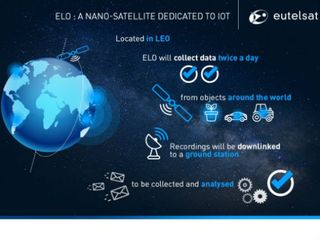Eutelsat Developing Low Earth Orbit Satellite for IoT Services

Eutelsat Communications said it has tapped Tyvak International to build a low earth orbit (LEO) satellite that’s designed to support Internet of Things-focused apps and services.
The resulting Eutelsat LEO for Objects, or ELO (not to be confused with this ELO) service, will be used to assess the performance of LEO satellites in providing narrowband connectivity.
Eutelsat said it will also work with Sigfox, which runs a global narrowband network dedicated to IoT. Part of that work will include the analysis of spectrum used by the satellite in ISM Industrial, Scientific and Medical) frequency bands. ELO will also test connectivity in other bands.
Eutelsat said low earth orbit is well-suited for narrowband connectivity for IoT, noting that the satellite will be located on a sun-synchronous orbit at an altitude of between 500 km to 600 km.
RELATED: Broadband's Space Race Heats Up
Eutelsat expects ELO to launch in 2019 and backhaul information from objects located in areas that are not served by terrestrial networks and to offer a redundancy for existing terrestrial network coverage. The plan is also for ELO to collect data twice a day from IoT objects like connected vehicles, with data downloaded to a ground station in Svalbard, a Norwegian archipelago in the Arctic Ocean, for collection and analysis.
“With the expansion of the Internet of Things, new services are being developed in a wide range of sectors including smart cities, the mining industry, agriculture and logistics,” Jean-Hubert Lenotte, Eutelsat’s chief strategy officer, said in a statement.
Dish Network is also getting a fix on narrowband IoT, announcing last month that it will spend $1 billion on the first phase of such a wireless buildout using licensed spectrum.
Multichannel Newsletter
The smarter way to stay on top of the multichannel video marketplace. Sign up below.
